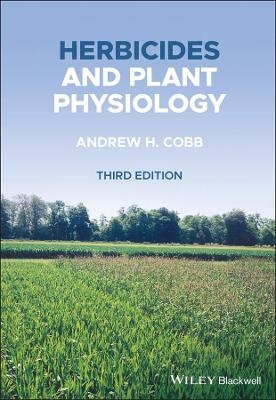
Herbicides and Plant Physiology
Wiley-Blackwell (Verlag)
978-1-119-15769-4 (ISBN)
In the newly revised Third Edition of Herbicides and Plant Physiology, distinguished researcher Professor Dr. Andrew H. Cobb delivers an insightful and comprehensive examination of the interaction between herbicides and plant physiology. The book discusses many of the advances in plant physiology, utilizing data from the Arabidopsis genome, and gene editing techniques that have occurred in the last dozen years.
This latest edition includes a variety of new and recent references addressing the latest developments in plant research. In addition to a complete introduction to weed biology, the book discusses the modern plant protection industry and the processes by which herbicides are discovered and developed.
Readers will find discussions of new targets for the future development of new herbicides, as well as the mechanisms by which modern herbicides interact with plants and achieve their weed control objectives.
The book also offers:
Thorough introductions to weed biology, the modern plant protection products industry, and how herbicides are discovered and developed
Comprehensive explorations of how herbicides gain entry into the plant and move to their sites of action, as well as the basis of herbicide selectivity
Practical discussions of how herbicides interact with the major physiological processes in plants and accomplish weed control, including the inhibition of photosynthesis, pigment biosynthesis, and more
Reviews recent developments following the use of genetically modified-herbicide resistant crops
Perfect for plant biologists and agricultural scientists, this latest edition of Herbicides and Plant Physiology is an indispensable resource for anyone seeking a comprehensive and robust treatment of the latest advances in plant physiology and herbicide action.
Andrew H. Cobb, Formerly Emeritus Professor of Plant Science, Dean of Academic Affairs and Director of Research at Harper Adams University, Shropshire, UK.
Preface
1. An Introduction to Weed Biology
1.1 Introduction
1.2 Distribution
1.3 The importance of weeds
1.4 Problems caused by weeds
1.5 Biology of weeds
1.6 A few examples of problem weeds
1.7 Positive attributes of weeds
1.8 The ever-changing weed spectrum
1.9 Weed Control
References
2. Herbicide Discovery and Development
2.1 Introduction
2.2 Markets
2.3 Prospects
2.4 Environmental impact and relative toxicology
2.5 Chemophobia
2.6 The search for novel active ingredients
2.7 The search for novel target sites
2.8 Mode of action studies
2.9 The role of natural chemistry
2.10 Recent developments
2.11 A lower limit for rates of herbicide application
References
3. Herbicide Uptake and Movement
3.1 Introduction
3.2 The cuticle as a barrier to foliar uptake
3.3 Physico-chemical aspects of foliar uptake
3.4 Herbicide formulation
3.5 Uptake by roots from soil
3.6 Herbicide translocation from roots to shoots
3.7 A case study: The formulation of acids
3.8 The formulation of glyphosate
3.9 Further developments
References
4. Herbicide Selectivity and Metabolism
4.1 Introduction
4.2 General principles
4.3 Herbicide safeners and synergists
References
5. Herbicides That Inhibit Photosynthesis
5.1 Introduction
5.2 Photosystems
5.3 Inhibition at Photosystem II
5.4 Photodamage and repair of Photosystem II
5.5 Structures and uses of Photosystem II inhibitors
5.6 Interference with electron flow at Photosystem I
5.7 RuBisCO activase
5.8 How treated plants die
5.9 Chlorophyll fluorescence
5.10 Inhibition of photosynthetic carbon reduction in C4 plants
References
6. Inhibition of Pigment Biosynthesis
6.1 Introduction: Structures and functions of photosynthetic pigments
6.2 Inhibition of chlorophyll biosynthesis
6.3 Inhibition of carotenoid biosynthesis
6.4 Inhibition of plastoquinone biosynthesis
6.5 How treated plants die
6.6 Selectivity and metabolism
6.7 Summary
References
7. Auxin-Type Herbicides
7.1 Introduction
7.2 Structure and uses of auxin-type herbicides
7.3 Auxin, a natural plant growth regulator
7.4 Biosynthesis and metabolism of auxins
7.5 Auxin receptors, gene expression and herbicides
7.6 Signal transduction
7.7 Auxin transport
7.8 Resistance to auxin-type herbicides
7.9 An “auxin overdose”
7.10 How treated plants die
7.11 Selectivity and metabolism
References
8. Inhibitors of Lipid Biosynthesis
8.1 Introduction
8.2 Structures and uses of graminicides
8.3 Inhibition of lipid biosynthesis
8.4 Activity of graminicides in mixtures
8.5 How treated plants die
8.6 Plant oxylipins: Lipids with key roles in plant defence and development
8.7 Selectivity
References
9. Inhibition of Amino Acid Biosynthesis
9.1 Introduction
9.2 Overview of amino acid biosynthesis in plants
9.3 Inhibition of glutamine synthetase
9.4 Inhibition of aromatic amino acid biosynthesis
9.5 Inhibition of branch-chain amino acid biosynthesis
9.6 Inhibition of histidine biosynthesis
References
10. Disruption of the Plant Cell Cycle
10.1 Introduction
10.2 The plant cell cycle
10.3 Control of the plant cell cycle
10.4 Microtubule structure and function
10.5 Herbicidal interference with microtubules
10.6 Selectivity
References
11. The Inhibition of Cellulose Biosynthesis
11.1 Introduction
11.2 Cellulose biosynthesis
11.3 Cellulose biosynthesis inhibitors
11.4 How treated plants die
11.5 Selectivity
References
12. Plant kinases, phosphatases and Stress Signalling
12.1 Introduction
12.2 Plant kinases
12.3 Plant phosphatases
12.4 Cyclin-dependent kinases and plant stress
12.5 Post-translational modification of proteins
References
13. Herbicide Resistance
13.1 Introduction
13.2 Definition of herbicide resistance
13.3 How herbicide resistance occurs
13.4 A chronology of herbicide resistance
13.5 Mechanisms of resistance
13.6 Case Study: Blackgrass (Alopecurus myosuroides Huds)
13.7 Strategies for the control of herbicide-resistant weeds
13.8 The future development of herbicide-resistance
References
14. Herbicide-Tolerant Crops
14.1 Introduction
14.2 History of genetically-modified, herbicide-tolerant crops
14.3 How genetically-modified crops are produced
14.4 Genetically engineered herbicide-tolerance to glyphosate
14.5 Genetically-modified herbicide-tolerance to glufosinate
14.6 Genetically-modified herbicide-tolerance to bromoxynil
14.7 Genetically-modified herbicide-tolerance to sulphonylureas
14.8 Genetically-modified herbicide-tolerance to 2,4-D
14.9 Genetically-modified herbicide-tolerance to fops and dims
14.10 Genetically-modified herbicide -tolerance to phytoene desaturase inhibitors
14.11 Herbicide-tolerance due to engineering of enhanced metabolism
14.12 Herbicide-tolerance through means other than genetic modification
14.13 Gene editing
14.14 Economic, environmental and human health benefits from the adoption of GM technology
14.15 Gene stacking
14.16 Will the rise of glyphosate be inevitably followed by a fall?
14.17 Why is there so much opposition to GM technology?
14.18 Future prospects
References
15. Further Targets For Herbicide Development
15.1 Introduction
15.2 Protein turnover
15.3 The promotion of ageing in weeds?
15.4 Herbicide leads at the apicoplast
15.5 Control of seed germination and dormancy
15.6 Natural products as leads for new herbicides
References
Glossary
Index
| Erscheinungsdatum | 07.03.2022 |
|---|---|
| Verlagsort | Hoboken |
| Sprache | englisch |
| Maße | 170 x 244 mm |
| Gewicht | 680 g |
| Themenwelt | Naturwissenschaften ► Biologie |
| Naturwissenschaften ► Chemie | |
| Weitere Fachgebiete ► Land- / Forstwirtschaft / Fischerei | |
| ISBN-10 | 1-119-15769-2 / 1119157692 |
| ISBN-13 | 978-1-119-15769-4 / 9781119157694 |
| Zustand | Neuware |
| Haben Sie eine Frage zum Produkt? |
aus dem Bereich


